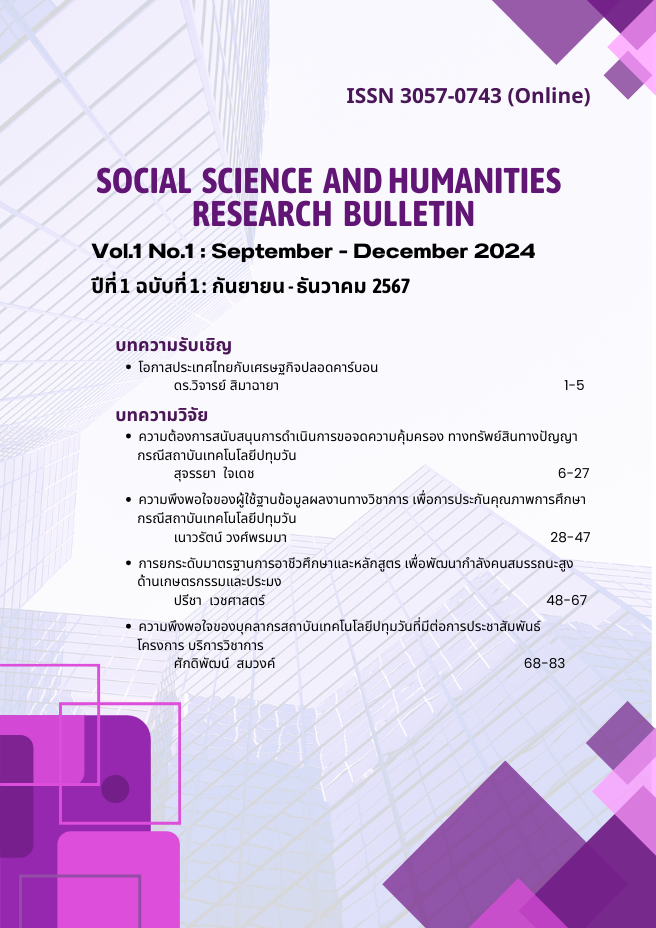Satisfaction of Users with the Academic work Database for Educational Quality Assurance at Pathumwan Institute of Technology
Keywords:
Satisfaction, Academic Work, Educational Quality AssuranceAbstract
The purpose of this study were as follow; (1) To compare satisfaction with academic work databases for quality assurance in all study groups and (2) To compare the differences in satisfaction with the use of academic performance databases for quality assurance of education between the curriculum secretary group and the faculty management in terms of accuracy of academic performance data details, utilization, design, and aesthetics. The population of this study consists of 2 personnel who are responsible for quality assurance at the Pathumwan Institute of Technology, including (1) 10 project secretaries and (2) 10 faculty administrators conducting research by designing a scale questionnaire, assessment Likert Scale 5 levels. Which has passed the quality inspection of the tool with the accuracy of the structure and the accuracy of the content and content validity. The analytical of this research comsits of descriptive statistic and inferential statistic i.e. 1) Kolmogorov-Smirnov One Sample Test 2) Freidman Two-way Analysis of Variance by Ranks 3) Kolmogorov-Smirnov Two Sample Test and 4) Mann-Whitney U Test. Comparative results of satisfaction differences with the use of academic work databases to ensure the quality of education of all student groups in 3 areas deserved the satisfaction of those who use all academic work databases to ensure the quality of education, all study groups regarding the accuracy of academic performance data details use design and beauty. There are statistically significant differences at 0.05 level. The results will compare the satisfaction differences with the use of the resulting database, academic work to ensure the quality of education of 2 study groups in each of the 3 areas found that the accuracy of the academic performance data consists of design and aesthetics, statistical significance at 0.05 confidence level. The suggestions of the study are 1) The Pathumwan Institute of Technology should have a budget support policy to develop an academic portfolio database system for quality assurance of education of the Pathumwan Institute of Technology to support ongoing obstruction, according to the mission of the institution and 2) Pathumwan Institute of Technology should select personnel with expertise in terms of academic performance and art, website design development consultant, and academic work database system For quality assurance education will continue to be effective.
Keywords: Satisfaction; Academic Work Data; Educational Quality Assurance
References
คณะกรรมการประกันคุณภาพภายในระดับอุดมศึกษา คณะอนุกรรมการพัฒนาการประกันคุณภาพ
การศึกษาภายในระดับอุดมศึกษา. (2560). คู่มือประกันคุณภาพการศึกษาภายใน
ระดับอุดมศึกษา พ.ศ. 2557 (พิมพ์ครั้งที่ 3). สำนักงานคณะกรรมการการอุดมศึกษา.
ณัฎฐภรณ์ หลาวทอง. (2559). การสร้างเครื่องมื่อวิจัยทงการศึกษา. โรงพิมพ์แห่งจุฬาลงกรณ์มหาวิทยาลัย.
พิชญา หอมหวล และธีระวัฒน์ จันทึก. (2561). ความพึงพอใจในการปฏิบัติงานของบุคลากรภาครัฐต่อการเป็นมหาวิทยาลัยในกำกับของรัฐ. วารสารมหาวิทยาลัยศิลปากร, 38(5), 80-98.
วรรณี แกมเกตุ. (2555). วิธีวิทยาการวิจัยทางพฤติกรรมศาสตร์ (พิมพ์ครั้งที่ 3). จุฬาลงกรณ์มหาวิทยาลัย.
สถาบันเทคโนโลยีปทุมวัน. (2565). รายงานผลการตรวจประเมินตนเอง (Self-Assessment Report : SAR) สถาบันเทคโนโลยีปทุมวัน ประจำปีการศึกษา 2564. สถาบันเทคโนโลยีปทุมวัน.สำนักวิจัยและบริการวิชการ สถาบันเทคโนโลยีปทุมวัน (2565). แผนพัฒนาคุณภาพการศึกษา(Improvement Plan) ประจำปีการศึกษา 2565 สำนักวิจัยและบริการวิชาการ.
สุธรรม ขนาบศักดิ์. (2558). ความพึงพอใจของผู้รับบริการที่มีต่อการให้บริการขององค์กรปกครองส่วนท้องถิ่น ปีงบประมาณ พ.ศ. 2557. วารสารมนุษยศาสตร์สังคมศาสตร์ มหาวิทยาลัยทักษิณ, 10(1), 35-51.
เอมีล่า แวอีซอ. (2565). ความแตกต่างระหว่างเจเนอเรชันและความพึงพอใจงานของบุคลากร: กรณีศึกษาอาจารย์ในมหาวิทยาลัยสงขลานครินทร์ วิทยาลัยภูเก็ต. วารสารวิเทศศึกษา, 12(1), 179-206.
Likert, R. (1961). New Patterns of Management. McGraw Hill Book.
Siegel, Sidney. (1956). Nonparametric Statistics for Behavioral Science. McGraw-Hill Book.

